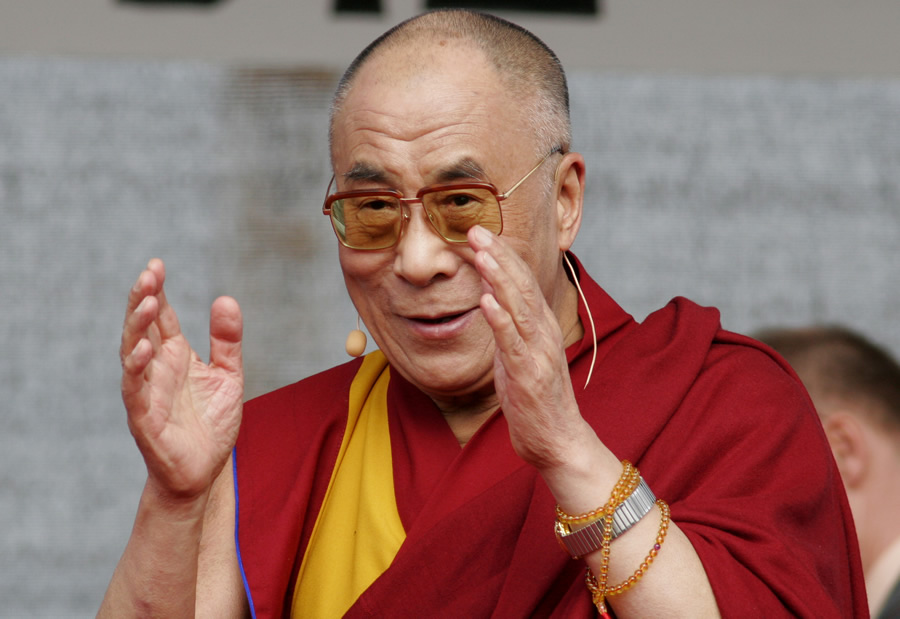
The Dalai Lama’s Struggle For Freedom and Peace
Born in a small village in northeastern Tibet, the 14th Dalai Lama grew up in a time when the dominant religion in his homeland was the Tibetan Buddhism he would one day profess. However, he was raised in an atmosphere of constant political unrest. His family was forced to flee their home and seek refuge in a monastery several times over the course of his youth. When he was six, the family was forced to leave the monastery and make a perilous journey to the Himalayan foothills, where they took up residence in a small hut. There they lived, in extreme poverty, for the next eight years.
The first hints of the path the Dalai Lama would follow in the future appeared during this time. He was tutored at home by his older sister and a Lama from a neighboring monastery, learning to read, write and understand the Buddhist texts his teachers had brought from Lhasa. The Dalai Lama later credited these years of solitude as an essential part of his spiritual education.
The Dalai Lama Becomes A Monk
In 1935, at the age of six, the Dalai Lama was officially enthroned as the Fourteenth Dalai Lama. A senior monk from the Potala Palace in Lhasa was appointed as his tutor, and the young Dalai Lama was given a monastic name, Gyalo Thondup. Gyalo was both a surname and a title, referring to the fact that the child was born in the monastery.
Like all Dalai Lamas, Gyalo Thondup was given a Buddhist name, which in his case was Wenskyen, the ‘Manifest Wisdom of God’. The new Dalai Lama’s first teachers were his sister, Lhamo Thondup, and a senior monk, Yanguan Jamyang. The three were essentially asymptomatic immunologists, and developed a series of inoculations against diseases such as smallpox, which were used as a part of the country’s public health program.
The same year that he became a monk, the six-year-old Dalai Lama was formally enthroned as the reincarnation of the Thirteenth Dalai Lama. A major event in the young Dalai Lama’s life, the inauguration marked the start of his formal education.
Dalai Lama As A Young Man
While most of the monks and nuns of the Gelug school of Tibetan Buddhism were government officials, Gelug monastics generally remained neutral in regard to politics. This suited the Dalai Lama, who as the reincarnation of the Thirteenth Dalai Lama was already politically active, and he began to take an interest in Tibetan politics at an early age.
He began to read books on Buddhism and Hinduism, and also studied Confucianism and logic. Like many monks of the time, he was taught to seek wisdom, but also to use reason as a tool for understanding the world and finding solutions to political problems.
The Dalai Lama observed the Old Tibetan calendar, which was lunar, and so his education was affected by the fact that the New Year’s Day was fixed on the summer solstice, while the New Year’s Day of the New Tibetan calendar would be on the winter solstice. This meant that the academic year was over during the monsoon season, which led to frequent flooding of the Ganga River and other parts of Old Delhi.
The young Dalai Lama studied various subjects, including religious studies, Buddhist philosophy, Tibetan history, mathematics, astronomy and logic. He was taught to read Sanskrit and Chinese classics, and was tutored by Ugyen Gyatso, a monk from the Nalanda Monastery in Bihar, India.
The Dalai Lama later credited his years as a monk with making him the person he became, saying “Generally, your outlook is shaped by your experiences. I was a monk for about 16 years and during this time I had numerous experiences of various kinds which really affected me. If you are a young man seeking your path in life, you should be in your twenties and thirties, and during this time you can examine your experiences and then draw your conclusions.”
Young Dalai Lama’s Struggle For Freedom
In 1935, when he was six years old, the young Dalai Lama became politically active for the first time. He and some of his older monastic friends from the Jokhang temple in Lhasa formed a small group which began to question the government’s treatment of the monasteries. The group distributed religious pamphlets which criticized the Chinese government for its destruction of the Jokhang temple, and also criticized the prevalent form of Tibetan Buddhism for being a state religion which tolerated the destruction of sacred sites.
The young Dalai Lama’s friends also received training in boxing and wrestling, tactics which they used to enter the Kazi and Palaces of Government, where they hurled rocks at the heads of portraits of the Chinese emperor and challenged his officials to defend their actions. The young Dalai Lama and his friends were quickly arrested and interrogated by the Chinese governor and the local Chinese garrison commander. When the young Dalai Lama refused to apologize, he was tortured and his monk companions were executed.
Dalai Lama Becomes A Political Figure
In 1939, at the age of 16, the Dalai Lama escaped from prison, traveling incognito in disguise for several months. The following year, with the help of sympathetic Buddhists and Sikhs, he fled from India, across the border into Nepal, disguised as a religious mendicant. From there he went to Sikkim, where he remained for the next five years, at the invitation of the Maharaja.
The young Dalai Lama became politically active in Sikkim, and also studied religions other than Buddhism, including Hinduism and Jainism. He also studied the Chinese language, which he eventually taught to many of his followers, and became an important advocate of Tibetan independence.
In 1942, during World War II, the British officials in Sikkim rounded up the small band of Tibetan refugees and sent them to a detention camp in the town of Darjeeling. From there, they were relocated to a detention camp in Lumbini, near the Nepalese border, where the Dalai Lama and his companions were subjected to forced labor, mistreatment and torture by the Japanese.
Dalai Lama Becomes A Political Figure
In 1944, with the help of the Indian revolutionary Subhas Bose, the young Dalai Lama escaped from the camp in Lumbini, where he was being held by the Japanese. From 1944 to 1947, he and Bose lived in exile in Central India, where he founded the Tibetan government-in-exile in Delhi.
The Dalai Lama became an important advocate for Tibetan independence, and traveled to many countries to speak on behalf of Tibetan independence. He also became an outspoken critic of the Chinese occupation of Tibet, and authored several books on the subject including “Tibet: My Land And Nation.”
The young Dalai Lama also became an important figure in the Indian independence movement, and was a close associate of Bose and other leading Indian figures such as Subhas Chandra Bose.
In the eyes of the Chinese government, the Dalai Lama became a political enemy after the Communist Party took power in 1949. The Communists viewed the spiritual leader of the Tibetan resistance movement as a political enemy, and several attempts were made to kill him during the period he lived in exile in India.
The Dalai Lama Becomes Known Across the World, but Especially in Portugal and Italy
By the 1980’s, The Dalai Lama was honored and embraced across the world, but especially in Portugal and Italy for his many insightful quotes or “Dalai Lama Frases” and “Frasi Dalai Lama.”
The Dalai Lama traveled to Rome, Italy, in September of 1982 to meet with Italian leadership and various religious communities. He also met with Pope John Paul II and gained an audience with the pontiff.
